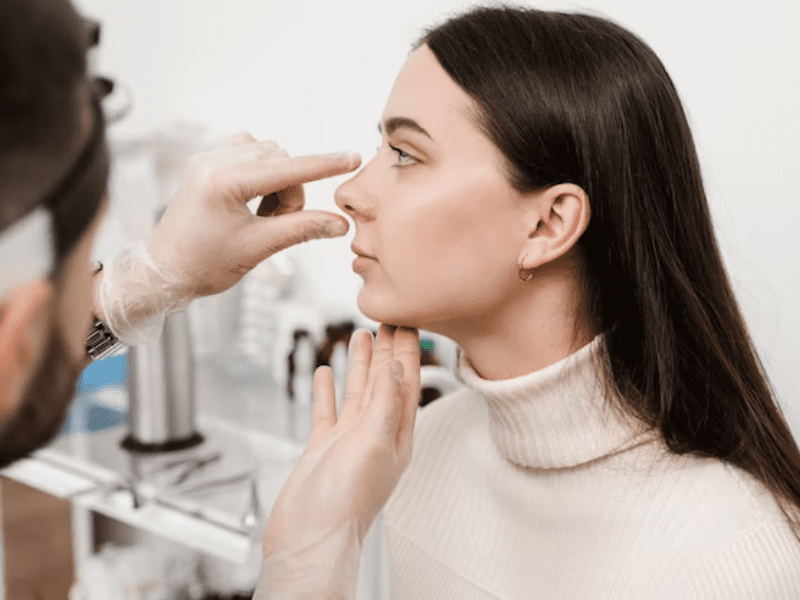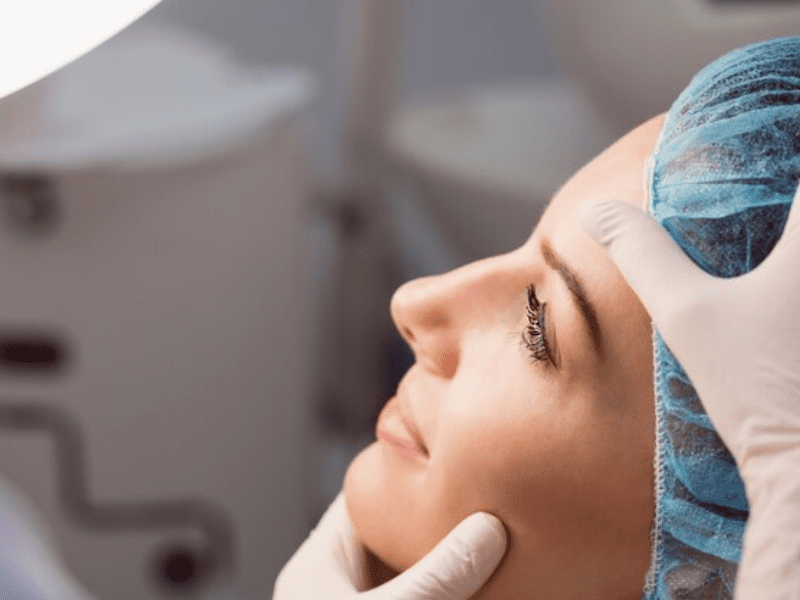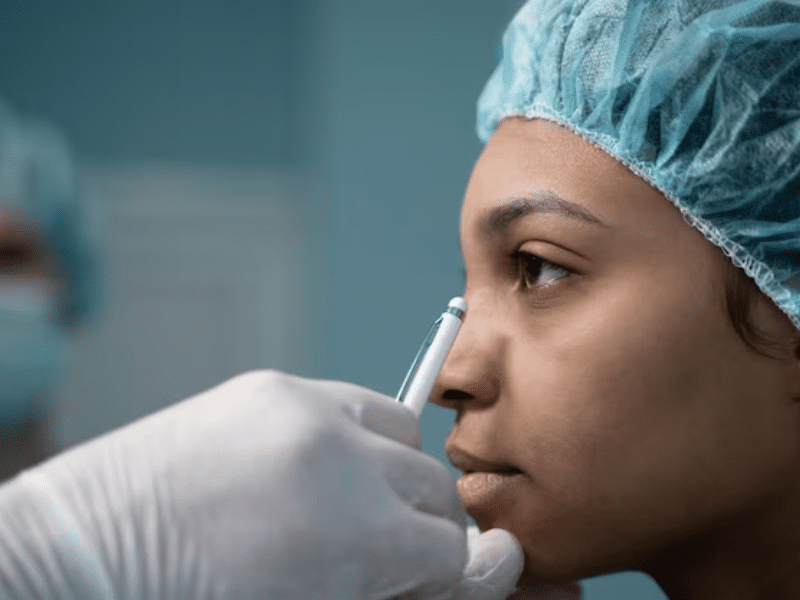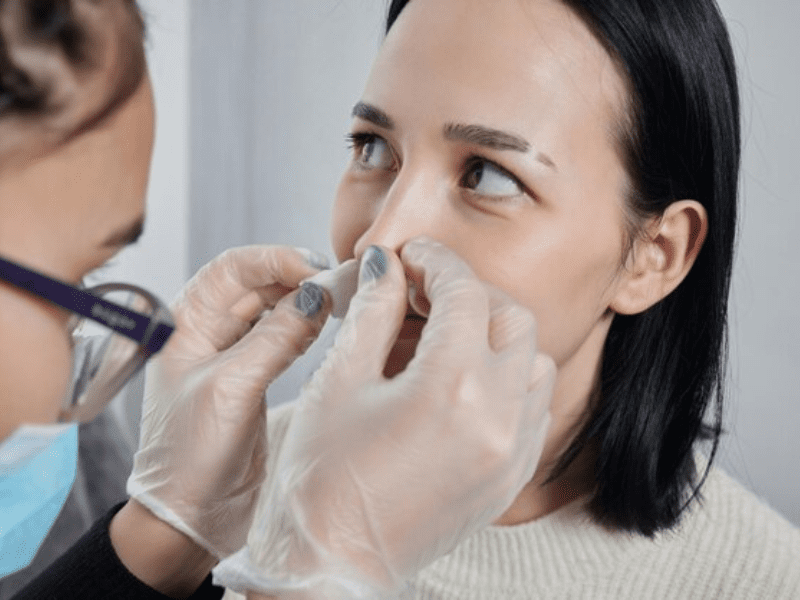Nasal Tip Surgery Recovery Time; Week by Week
The typical nasal tip surgery recovery time is approximately one year, though individual experiences may vary. Breaking down this timeline into milestones provides a clearer understanding of the process:
-
1 Week:
- At this point, the splint can be removed, allowing you to venture into public without conspicuous signs of surgery, unless there’s residual bruising around the eyes, which might take an additional 2 weeks to fully resolve. It’s safe to resume normal daily activities.
-
2 Weeks:
- Facial swelling has significantly diminished, and most bruising should have disappeared.
-
3-4 Weeks:
- Cardiovascular activities such as jogging, swimming, and cycling can be safely resumed.
-
6 Weeks:
- Bones are stable, enabling the resumption of resistance workouts (weight lifting), as well as the use of glasses and the ability to blow your nose.
-
3-6 Months:
- Numbness and unusual sensations in the nose and nasal skin should largely resolve during this period.
-
1 Year:
- The healing process is considered complete. Swelling should have entirely subsided, and the nose’s new shape is fully refined. Individual results may vary, but generally, this marks the conclusion of the nasal tip surgery recovery time.
Click (Guide to Bulbous Nose Tip Surgery Recovery) to read the article.

Rhinoplasty Surgery Can Fix These Conditions
Reshaping a bulbous nasal tip (which is talked about in this passage about nasal tip surgery recovery), straightening a crooked nose, smoothing out bridge bumps or scoops, and narrowing nasal bones are all aspects of rhinoplasty. Additionally, this surgical procedure can address issues related to breathing, sinuses, and snoring.
The transformative results of a Bulbous Nose Rhinoplasty can be remarkable, not just physically but also in terms of the impact on your life. The boost in confidence and overall mental well-being is significant.
Click (What are Middle Eastern nose features?) to read the article.

What Happens in Bulbous Nose Rhinoplasty?
Following a thorough consultation, your surgeon will determine whether to proceed with an open or closed procedure. In the closed approach, incisions are made inside the nose, while the open procedure involves an additional incision across the columella, the strip of tissue between the nostrils. The primary distinction lies in the open procedure providing enhanced access to specific areas of the nose.
The surgeon will administer general anesthesia before commencing the procedure. Depending on the requirements, cartilage grafts may be performed, and the skin around the nasal tip may be thinned. Some cartilage might be removed, and suturing will be carried out to refine the shape of your nose.
Typically lasting between 2 to 2½ hours, the surgery will be followed by your awakening in the recovery room. Subsequently, a friend or loved one will be able to accompany you home immediately after the surgery. After the surgery, you have to go through a nasal tip surgery recovery time.
Click (The Ultimate Guide to Nose Job in Iran or Turkey) to read the article.

Some Solutions to Ease the Nasal Tip Surgery Recovery Time
In this section, we have briefly talked about the necessary solutions to ease the nasal tip surgery recovery time;
Pay Attention to Your Body:
While your plastic surgeon can assess your nasal tip surgery recovery time externally, only you can truly gauge how you’re feeling. Be attuned to your body, if anything feels off post-surgery, promptly communicate it with your doctor for discussion and guidance.
Maintain Elevation for Your Head:
Avoiding side-sleeping after rhinoplasty is crucial, not only for comfort but also to prevent prolonged recovery due to increased bruising and swelling. Additionally, it helps prevent the displacement of your nose. To achieve this, it’s recommended to keep your head elevated at night for six weeks post-surgery. You can easily achieve this by using two or three pillows or opting for a foam wedge. Another effective method is sleeping in a reclined position.
If you have a habit of shifting positions during sleep, you can stabilize your head using a travel pillow or by creating a barrier with rolled-up towels.
Utilize Cold Compresses:
During the initial 72 hours post-surgery, incorporating cold compresses can effectively minimize swelling. However, exercise caution and avoid direct application to your nose. Instead, place the compress on your cheeks to prevent unintentional shifting of bones or cartilage.
Prioritize Adequate Rest:
Post-surgery congestion may pose challenges for falling asleep, but sufficient rest is crucial for the recovery journey. Your body utilizes energy to facilitate healing, and obtaining a consistent seven or eight hours of sleep nightly provides the necessary time for your body to replenish that energy.
Maintain A Nutritious Diet:
The connection between eating vegetables and recovering from a nose job in iran is more significant than one might think. Adopting a well-balanced diet post-surgery can accelerate the recovery process by providing the necessary nutrients for self-healing.
Protein, a fundamental component for skin, muscle, cartilage, and blood, is crucial for rebuilding damaged tissue in and around your nose. Include nuts, meat, eggs, yogurt, fish, and other protein-rich foods in your diet.
Ensure an ample intake of vitamins, particularly Vitamin A and Vitamin C. Vitamin A, abundant in dark, leafy greens like spinach and kale, serves as an immune booster, aiding in infection prevention post-surgery. Vitamin C plays a vital role in collagen regeneration, connecting skin tissues. Incorporate sources of Vitamin C such as citrus fruits, Brussels sprouts, and broccoli into your diet.

Avoid Nose Blowing:
Following surgery, you may encounter nasal congestion for several weeks, possibly even months, due to swollen nasal tissues. Refrain from the temptation to blow your nose, and consult your doctor about utilizing a saline nasal spray to delicately moisturize your nasal passages until the swelling subsides. It’s advisable to wait until six weeks post-surgery before resuming nose blowing.
Regarding sneezing, it’s not always within your control. Instead, try to sneeze through your mouth rather than your nose. While it might seem unpleasant, opting for this method is preferable to risking harm to your delicate nasal passages and potentially prolonging your nasal tip surgery recovery time.
Avoid Intense Physical Activity:
Typically, it takes about six weeks for the nasal bones to fully heal after surgery. Throughout this period, it’s crucial to steer clear of strenuous exercise. Even seemingly innocuous activities like stretching, lifting, or bending over can contribute to increased nasal swelling. Wait for your doctor’s approval before gradually reintroducing regular physical activity into your routine.
Avoid Wearing Glasses:
Whether they are sunglasses, reading glasses, or prescription glasses, any eyewear that exerts pressure on your healing nose can lead to additional bruising, swelling, or indentations that may necessitate revision rhinoplasty in the future.
Your facial plastic surgeon will guide you on when it’s safe to resume wearing glasses. In the interim, consider using contact lenses if possible. If not, opt for the lightest frames available and wear them only when absolutely necessary.
Avoid Smoking:
It is crucial to refrain from smoking both before and after surgery, and if possible, steer clear of secondhand smoke. Nicotine in tobacco products restricts blood flow, impeding the body’s natural healing processes and adversely affecting your nasal tip surgery recovery time.
Causes of a Bulbous Tip
The rounded or “boxy” appearance of the nasal tip can stem from various factors such as genetics, trauma, or the natural aging process. Below, we’ll delve deeper into the factors contributing to a bulbous tip:
Genetics:
The shape of the nose can be influenced by genetics, with some individuals naturally having a more bulbous tip from birth.
Trauma:
Nose injuries, whether from direct impact or previous rhinoplasty procedures, can alter the tip’s shape, leading to a bulbous appearance.
Aging:
The aging process also plays a role in nose shape, as the reduction of collagen and elastin in the skin over time can result in a softer and more rounded tip.
Cartilage and Bone Structure:
The underlying cartilage and bone structure of the nose contribute to the tip’s shape. Thicker or more defined cartilage or bone can give the tip a bulbous appearance. In certain cases, correction of a bulbous tip may be achievable through rhinoplasty or other cosmetic interventions.
source:Speed Up Your Nasal Tip Surgery Recovery Time
 تست سمیت سلولی
تست سمیت سلولی